Lesson: Balloon Aeronautics
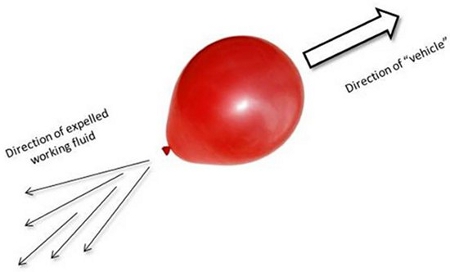
(Adapted from lessons developed by TeachEngineering.org, the Wisconsin section of the Society of Women Engineers. Illustrations from NASA.)
In this lesson, teams of students in grades 4 – 8 learn about basic aerodynamics by constructing a rocket from a balloon propelled along a guide-string. They use this model to learn about Newton’s three laws of motion, examining the effect of different forces on the motion of the rocket.
Grade level: 4 – 8
Time: 45 mins. – 1 hour (15 minutes prep & lecture time, 30 minutes for the activity)
LEARNING OUTCOMES
After doing this activity, students should be able to:
- Understand practical applications of Newton’s Laws of Motion
- Use the model of the balloon to understand the different forces that act on the rocket
- Collect data from the experiment and graph the results
LEARNING STANDARDS
National Science Education Standards:
- Physical Science: Properties of Objects and Materials (K-4)
- Motions and Forces (4-8)
- Science as Inquiry: Abilities necessary to do scientific inquiry
- Science and Technology Standard: Understanding about Science and Technology
Standards for Technology Literacy:
- The Nature of Technology. Students will develop an understanding of the role of troubleshooting, research and development, invention and innovation, and experimentation in problem solivng.
- The Designed World. Students will develop an understanding of and be able to select and use transportation technologies.
- Knowledge gained from other fields of study has a direct effect on the development of technological products and systems. (ITEA F. Grades 6-8)
INTRODUCTION
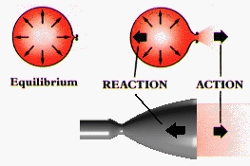 Engineers of all disciplines use their understanding Newton’s laws of motion to quantify the “invisible” forces acting on all objects. Just like a ball can be twirled on the end of a string, satellites and spacecraft stay in orbit around the Earth due to the balance between gravitational and centripetal forces. Eventually, satellites slow down due to the minuscule drag in the upper atmosphere, to the point at which gravity pulls them out of orbit. To keep them in orbit, engineers exploit the second law by designing thrusters that burn fuel and expel it from the thruster. The spacecraft moves forward in an amount equal to the force of the gas leaving the thruster, causing enough movement to reorient the path of the object and keep it in orbit.
Engineers of all disciplines use their understanding Newton’s laws of motion to quantify the “invisible” forces acting on all objects. Just like a ball can be twirled on the end of a string, satellites and spacecraft stay in orbit around the Earth due to the balance between gravitational and centripetal forces. Eventually, satellites slow down due to the minuscule drag in the upper atmosphere, to the point at which gravity pulls them out of orbit. To keep them in orbit, engineers exploit the second law by designing thrusters that burn fuel and expel it from the thruster. The spacecraft moves forward in an amount equal to the force of the gas leaving the thruster, causing enough movement to reorient the path of the object and keep it in orbit.
MATERIALS
For each group:
- Plastic drinking straw
- Plastic bag, about the size of an inflated balloon
- Paper streamers
- 25 ft. of fishing line (20-50g weight) or string (nylon [slippery] string works better than twine [rough])
- Long, tube-shaped balloon
- Tape measure or meter stick
Motivation. Start with an in-class demonstration. For example, have a student or the teacher stand on a skateboard and throw a basketball. What happens? Have a student or the teacher throw a basketball filled with lead weights or similar, very heavy object (this could be dangerous; be very careful not to fall). What happens? (Answer: The student or teacher rolls backwards on the skateboard.)
Rockets and rocket-propelled flight has been in use for more than 2,000 years. People in ancient China used gunpowder to make fireworks and rockets. In the past 300 years, people have gained a scientific understanding of how rockets work. Now, aerospace engineers use their understanding to make rockets fly farther, faster, higher and more accurately. Our understanding of how rockets work arises from Sir Isaac Newton’s three laws of motion. It is important for engineers to understand Newton’s laws because they not only describe how rockets work, they explain how everything that moves or stays still works!
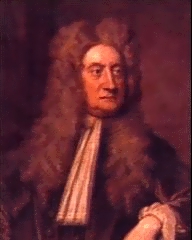 This activity demonstrates all three of Newton’s laws of motion. The air pushing its way out of the balloon is an action force, and it causes an equal reaction, which is the movement of the balloon. The more air initially in the balloon, the further the balloon travels along the string because the action force is greater. By the same token, if there is only a small amount of air initially in the balloon, the balloon travels a shorter distance.
This activity demonstrates all three of Newton’s laws of motion. The air pushing its way out of the balloon is an action force, and it causes an equal reaction, which is the movement of the balloon. The more air initially in the balloon, the further the balloon travels along the string because the action force is greater. By the same token, if there is only a small amount of air initially in the balloon, the balloon travels a shorter distance.
Simply stated, Newton’s three laws of motion are:
Law #1: Objects at rest will stay at rest, and objects in motion will stay in motion in a straight line unless they are acted upon by an unbalanced force. (law of inertia)
Law #2: Force is equal to mass multiplied by acceleration. (F = ma)
Law #3: For every action, there is always an opposite and equal reaction.
ACTIVITY
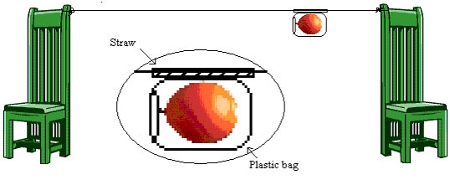
Copyright © Image created by Ashleigh Bailey, Integrated Teaching and Learning Laboratory, University of Colorado at Boulder, 2005
Gather materials and choose appropriate locations for students to set up the experiment.
With the Students:
- Have students vote on which of Newton’s three laws of motion applies to the flight of rockets. Tabulate votes on the board. (Answer: Trick question! All three laws apply.)
- Hand out a worksheet to each student.
- Tape a drinking straw along the side of a plastic bag (see diagram) *can also just tape balloon to straw*
- Tape streamers along the open edge of the plastic bag.
- Thread the string through the straw.
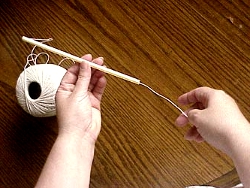
- Tie each end of the string to a chair, and pull the chairs apart so that the string is taut (see diagram).
- Position the bag at one end of the string, with the open end of the bag facing toward the chair.
- Blow up a balloon and put it into the bag, holding the balloon closed.
- Count down to zero, and let go of the balloon. . . ZOOMMM!
- Have students measure the distance their balloon rocket traveled on the string and complete the worksheet.
- While waiting for other students to finish their worksheets, students with completed worksheets should compare their answers with their peers.
- Review and discuss the worksheet answers with students.
The SWE lesson includes an explanation of the Newtonian laws at work on the balloon rocket.
Be sure the students blow up their balloon to different sizes — small, medium and large — to compare the different magnitudes of reaction that are produced.
Thicker fishing line (20-50g) works best for this activity. Next best is nylon string. Rough string or twine creates too much friction for the balloon to travel as far.
The string should be pulled taut for the balloon rocket launch. A slack string does not allow the balloon to travel as far.
 This activity can also be done without the plastic bag by taping the straw directly to the balloon. In this case, use large round balloons instead of long balloons.
This activity can also be done without the plastic bag by taping the straw directly to the balloon. In this case, use large round balloons instead of long balloons.
EXTENSIONS
- Run the experiment with a bigger or smaller balloon.
- Have the students fill up their balloons with water and repeat the experiment. Ask them why the balloon moved so slowly (if at all) and why. (Answer: Because the water is heavy, it takes more force to move water than air, and the water spills out of the balloon slowly (compared to air), therefore the reaction force is equally as slow as the action force. Note: This is messy! Make sure you follow the water-balloon with a bucket to catch the water or do this activity outside.
- Tape pennies to the outside of the rocket to increase the mass. How does increased mass affect the flight of the rocket? (Answer: Because of Newton’s second law, the same force exerted upon a larger mass will result in a lower acceleration – the rocket will not go as far!)
- Have the students re-engineer their balloon rockets again, adding extra features to make the balloon go further. Allow them to use more straw and tape, and more than one balloon. Conduct a race to see which engineering team built the best balloon rocket. Ask that team to explain why their design worked as it did, in terms of Newton’s three laws of motion.
- Ask the students to write a journal entry on how the balloon rocket experiment could relate to something else they’ve encountered. Why are Newton’s laws of motion so important in our world?
Watch a member of the St. Louis Science Center’s offsite team show how to make a simple rocket balloon that you can experiment with at home:
[youtube]http://www.youtube.com/watch?v=A7wrEWfV6TY[/youtube]
LINKS
Newton in Space. NASA’s engaging primer on Newton’s laws as they apply to spaceflight.
What is a Rocket? As NASA explains, it’s a lot like a balloon.
Credits:
- Teachengineering.org contributors Sabre Duren, Ben Heavner, Malinda Schaefer Zarske, Denise Carlson, Integrated Teaching and Learning Program, College of Engineering, University of Colorado at Boulder. © 2004 by Regents of the University of Colorado.
- Balloon photos from Society of Women Engineers
- Thrust and force illustrations from NASA
Filed under: Grades 6-8, Grades K-5, Lesson Plans
Tags: Aerospace, aerospace lessons, balloon rocket, forces, NASA, Newton's, Physics, rockets








